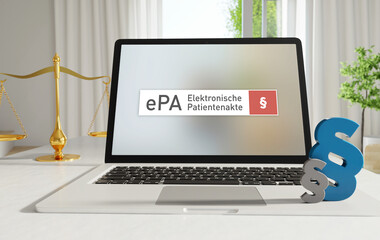
The electronic patient file is intended to digitally collate the patient data previously stored in different places such as practices and hospitals. The start in July was bumpy. The goal is now that the technology will be available nationwide in the practices of SHI-accredited physicians by the end of September, according to the Federal Ministry of Health.
Digitisation is on the rise everywhere, including in medicine and the entire health system - why should it be any different in these so important areas? The possibilities are already manifold. From apps for recording health and fitness data to video consultations and digital information platforms on all health topics, interested parties can take advantage of many exciting solutions.
The focus is on the digital patient share. According to the German Association of Statutory Health Insurance Physicians, the electronic patient file (ePA) is the central element of networked healthcare and the telematics infrastructure. It is intended to digitally collate the patient data previously stored in different places such as practices and hospitals. This means that patients have all relevant information such as findings, diagnoses, therapy measures, treatment reports, the medication plan and the emergency data record available at a glance and can make it available to their doctors, therapists and pharmacists.
Electronic patient file nationwide by the end of September?
But the introduction is less simple than hoped. The launch of the electronic patient record (ePA) was long announced for 1 July. However, Gottfried Ludewig, head of the digitisation department at the Federal Ministry of Health, now speaks of the ePA being in an introductory phase. "The goal is that the technology will be available nationwide in the practices of SHI-accredited doctors by the end of September," Gottfried Ludewig told the health protection newsletter "Handelsblatt Inside". It goes on to say that people with statutory health insurance should have been able to have their ePA - an app provided by the health insurance funds since the beginning of the year - filled with findings and other medical documents since the beginning of July. However, only a few doctors' offices were technically able to do this in July.
Handelsblatt Inside" also quotes Thomas Kriedel, member of the board of the National Association of Statutory Health Insurance Physicians. He confirms the problems, the business newspaper reports: "For many doctors in private practice, the use of the electronic patient file is not yet technically possible". He complains about the lack of updates from the connector and practice software manufacturers. A connector is a router with which doctors' practices can access the ePA via the telematics infrastructure (TI). Moreover, only a few patients would have downloaded the electronic record.
Better availability of findings, medication plans or X-rays
And Andreas Gassen, head of the National Association of Statutory Health Insurance Physicians (Kassenärztliche Bundesvereinigung), even told the "Tagesschau" that the electronic patient file would have no concrete benefit at all for people with statutory health insurance. So far, he says, there are only theoretical options for the file, such as better availability of findings, medication schedules or X-ray images. At the request of patients, medical practices and psychotherapists are obliged to store copies of patient-related documents in the ePA, the report says.
However, the sparse distribution so far could change quickly. Markus Leyck Dieken, head of Gematik, which provides the telematics infrastructure (TI) for the electronic patient file, told "Handelsblatt Inside" that he expects the insurance companies to promote the application after the summer, when all doctors would have the necessary technology. "I assume that the electronic patient file will then reach high single-digit millions relatively quickly," he predicts with a view to the number of users.
"Yellow booklet" for children's examinations digitally in the electronic patient file
The advantages are basically obvious. Through the electronic patient file, information on the state of health, previous illnesses, medication, vaccinations and other data should be easier to view and better network practices, pharmacies and hospitals. From 2022, the dental bonus booklet, the vaccination card, the maternity passport and the "yellow booklet" for children's examinations are to be able to be stored digitally in the file. The National Association of Statutory Health Insurance Physicians and the Hospital Association are still discussing how doctors' letters could be digitised and stored in the file upon discharge from hospital.
According to official submissions, no one should have to worry about data security. "The ePA is a patient-managed record. This means that only patients decide whether and how they want to use the file and to whom they want to make which data available. They also decide which documents are stored in the ePA and which are deleted. The ePA is to be considered a lifelong source of information. There may only be one ePA for each insured person. Doctors and psychotherapists may only access the ePA with the patient's consent. Every access is logged," documents the National Association of Statutory Health Insurance Physicians. This text may contain translation errors as the translation was done by an online translation tool.
This text may contain translation errors as the translation was done by an online translation tool.










